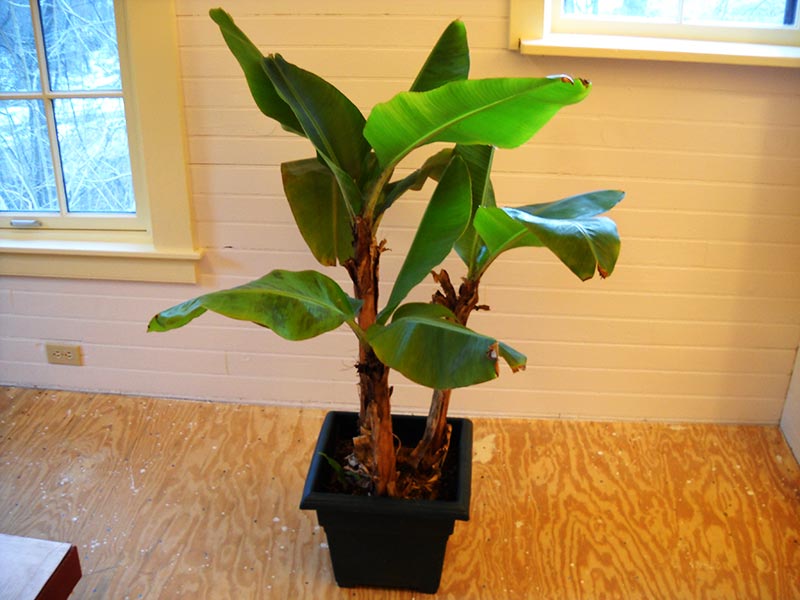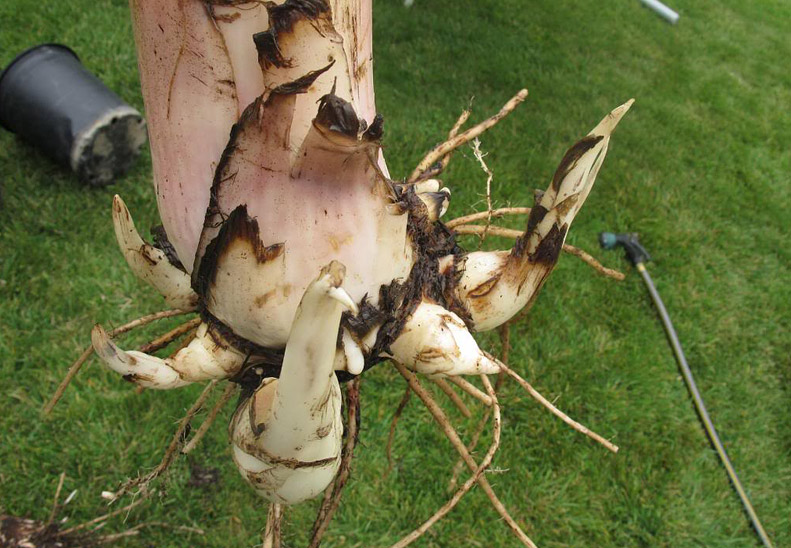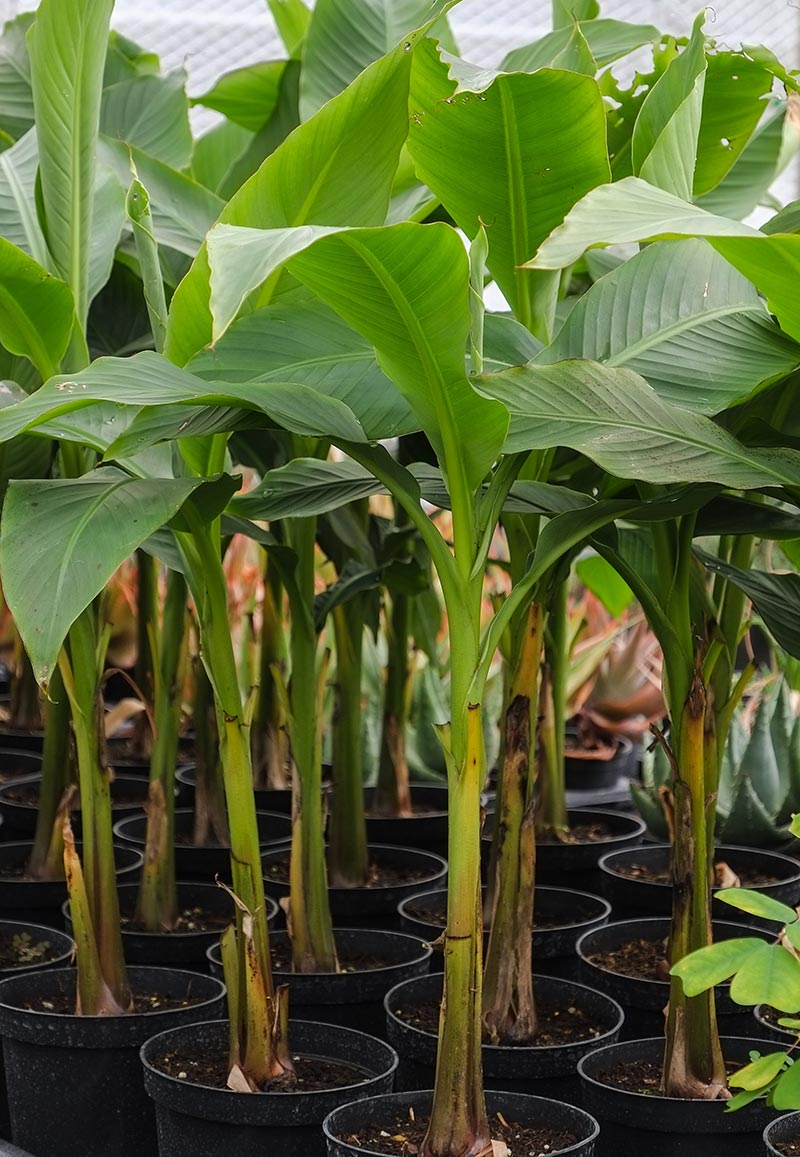How To Become More Self-Sufficient Without Starting a Full-Blown Farm…
Want to start preserving your harvest, making your own soap, or building a backyard root cellar — but not sure where to begin? “Homesteading Advice” gives you instant lifetime access to 35+ practical homesteading books on food preservation, veggie gardening, DIY natural cleaning products (save over $250 per year with this skill alone), brewing, off-grid energy, and a whole lot more…
Click Here To Check It Out Now!
Growing Banana trees in pots is easy, if you’re unable to grow it on the ground either due to lack of space or cold climate. Learn how to grow banana trees in this complete article.
There are banana varieties that can withstand temperature drops and grows well in containers, popular especially among the fans of exotic tropical plants in the garden. The first question that may come up in your mind is – Will a banana tree in a pot bear fruit? And the answer is yes. It is possible, a banana tree bears fruits in a pot prolifically. It may take up to 3 to 5 years to fruit if grown from seeds.

Growing Banana Trees in Pots
Banana is a lush green, fast-growing plant that can give any place a tropical look and feel. Many varieties become excellent houseplants that don’t need much care and grow up very quickly.
Dwarf varieties of banana trees can grow anywhere between 2 to 4 meters. Compared to the ordinary banana trees that can reach up to 15 meters high.
Growing Banana Trees in Pots in Tropics
Growing banana tree in pot in a tropical climate is extremely easy, with little to no care banana tree grows in the container. If you’re living under USDA Zones 9 to 11, keep your banana tree in the shade in afternoon in summer, when the plant is young. All the other requirements are similar as given below in the article for temperate zones.

Banana Varieties you can Grow in Pots and Indoors
These dwarf varieties of banana tree restrict up to only 1.5 m to 4 m. (4 to 12 feet) tall and are suitable to grow in containers. You can also grow these banana varieties indoors.
- Dwarf Red
- Dwarf Cavendish
- Dwarf Brazilian
- Dwarf Jamaican
- Rajapuri
- Williams Hybrid
- Gran Nain
- Dwarf ‘Lady Finger’

If you would like to grow ornamental bananas check out these varieties:
- Ensete ventricosum
- Musa sikkimensis ‘Red Tiger’
- Musa ornata
Requirements for Growing Banana Trees in Pots
Sun
Banana trees grow in tropical and subtropical parts of the world and therefore they love full sun, heat and humidity. If you’re growing banana tree you should keep it in a spot that receives the sun most of the day but preferably sheltered from the wind.
Soil
Growing Banana tree requires well-draining soil, sandy soil that is rich in organic matters and compost. Buy a good quality potting mix for your banana tree. If you are making it at home make sure to mix sand, perlite, and compost or manure.
Banana needs slightly acidic to neutral soil to produce those potassium rich nutritious bananas. The soil pH should be around 6 – 7. If your soil is alkaline mix sulfur to decrease the pH.

Watering
Banana loves moisture. Water it regularly and deeply but care not to overwater. In summer, water it every day. It may need water even two times a day in hot weather or when it is root bound. Soil for growing banana plants should be kept uniformly moist. Reduce watering in winter.
How to Plant?
Commercially grown bananas that are cultivated specifically for consumption don’t have seeds. Over time, they have been modified to have three sets of genes instead of two (triploid) and produce no seeds. In nature, however, one encounters many banana types with seeds; in fact, some seeds are so large it is difficult to get to the pulp. The banana you are eating for breakfast has been genetically tinkered with to lack seeds and are usually Cavendish bananas. There are many other banana varieties out there and they do contain seeds.
Cavendish bananas are propagated by pups or suckers, pieces of rhizome that form into miniature banana plants that can be severed from the parent and planted to become a separate plant. In the wild, bananas are propagated via seed. You, too, can grow seed grown bananas.
If you want to grow seed grown bananas, be aware that the resulting fruit will not be like those you buy at the grocers. They will contain seeds and, depending upon the variety, might be so large that the fruit is difficult to get to.
Growing from Seed
To begin germinating the banana seeds, soak the seed in warm water for 24 to 48 hours to break the seed dormancy. This softens the seed coat, enabling the embryo to sprout more easily and rapidly.
Use a seed tray or other container and fill with potting soil enriched with plenty of organic compost in the amount of 60% sand or airy, loam to 40% organic matter. Sow the banana seeds 1/4 inch deep and backfill with compost. Water the seeds until the soil is moist, not drenched, and maintain damp conditions while growing banana trees from seeds.
When germinating banana seeds, even hardy bananas, keep the temperature at least 60 degrees F. (15 C.). Different varieties respond to temperature fluxes differently, however. Some do well with 19 hours of cool and 5 hours of warm temps. Using a heated propagator and turning it on during the day and off at night may be the easiest way to monitor temperature fluctuations. The time that a banana seed germinates, again, depends on the variety. Some germinate in 2-3 weeks while others may take two or more months, so be patient when propagating banana plants via seed.

As each seed germinates, lift carefully from the tray so as to prevent any damage to the juvenile root system, and transfer it to a 3 in pot of good quality, free draining compost.
Banana Suckers
Every banana plant begins as an underground bulb from which the true stem grows. The stem develops through the center of the stalk, which than later produces fruit.
Each stalk supplies massive flower cluster which whiter away. In its place another stalk grows. The process keeps repeating itself until the tree produces fruit, typically after one year of cultivating new plant. To accelerate the process, fertilizers rich in potassium are recommended.
The suckers (pups) that grow at the base of the plant can be removed to propagate more new plants. After the plants have matured and produced fruit, it is important to leave at least one sucker in place as the mother plant will die if all the suckers are removed prematurely.

Banana Corm
Most banana plants come as bulbs or corms, but very few nurseries keep them in stack. They can be special ordered or they can be purchased from different vendors via online. When the shipment arrives, washing them in lukewarm water will ensure that any fungal deposits, debris and bacteria will be removed before planting. It will ensure proper potting and establishing the plant into its maturity.
The beginning stages of the banana plant should start in a medium-sized standard container with a drainage hole at the bottom to prevent standing water and assure proper ventilation for the developing roots. Once the corm is planted, it will need a combination of bright light, warmth and high humidity to start sprouting leaves.
Plant the rhizome upright leaving the top part uncovered to allow the light exposure. When several new leaves appear, the corm can be completely covered with soil to promote better stability and additional root growth. Replanting to a bigger pot will become necessary when the plant becomes container bound or it will stop bearing fruit.
Banana Plant in Pot Care
Humidity
Banana plant prefers humidity levels above 50%. To increase humidity level around the plant, mist the plant and place it on a layer of pebbles in a tray filled with water.
Overwintering Banana Tree
Banana plants stop growing when the temperature drops below 50 ° Fahrenheit. Before the onset of winter, do heavy mulching and prune the leaves. Put it in a warm, bright room till the spring.

Fertilizer
Banana is a fast growing plant and it requires heavy feeding to grow at its full strength. Fertilize young plant when it establishes well with nitrogen-rich fertilizer to help it grow faster. Once your banana tree in pot becomes mature enough to produce fruit, fertilize it with 15:5:30 fertilizer regularly.
Pests and diseases
Bananas are quite resistant to diseases, still when you see the leaves turning brown and drying at the edges it means you’re overwatering and if the leaves turn yellow, banana plant is having a lack of nutrients.
Some pests that might attack banana plant are banana aphids, banana weevil, and coconut scale. These pests can easily be repelled using organic pesticides (via SketchySloth)

If you like this idea, be sure to share it with your friends and inspire someone you know. Anything becomes possible with just a little inspiration…

